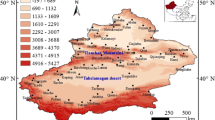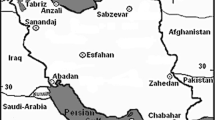Abstract
Climate change is likely to affect hydrological cycle through precipitation, evapotranspiration, soil moisture etc. In the present study, an attempt has been made to study the climate change and the sensitivity of estimated evapotranspiration to each climatic variable for a semi-arid region of Beijing in North China using data set from 1951 to 2010. Penman-Monteith method was used to calculate reference crop evapotranspiration (ETo). Changes of ETo to each climatic variable was estimated using a sensitivity analysis method proposed in this study. Results show that in the past 60 years, mean temperature and vapor pressure deficit (VPD) were significantly increasing, relative humidity and sunshine hours were significantly decreasing, and wind speed greatly oscillated without a significant trend. Total precipitation was significantly decreasing in corn season (from June to September), but it was increasing in wheat season (from October to next May). The change rates of temperature, relative humidity, VPD, wind speed, annual total precipitation, sunshine hours and solar radiation were 0.42°C, 1.47%, 0.04 kPa, 0.05 m·s−1, 25.0 mm, 74.0 hours and 90.7 MJ·m−2 per decade, respectively. In the past 60 years, yearly ETo was increasing with a rate of 19.5 mm per decade, and total ETos in wheat and corn seasons were increasing with rates of 13.1 and 5.3 mm per decade, respectively. Sensitivity analysis showed that mean air temperature was the first key factor for ETo change in the past 60 years, causing an annual total ETo increase of 7.4%, followed by relative humidity (5.5%) and sunshine hours (−3.1%); the less sensitivity factors were wind speed (0.7%), minimum temperature (−0.3%) and maximum temperature (−0.2%). A greater reduction of total ETo (12.3%) in the past 60 years was found in wheat season, mainly because of mean temperature (8.6%) and relative humidity (5.4%), as compared to a reduction of 6.0% in ETo during corn season due to sunshine hours (−6.9%), relative humidity (4.7%) and temperature (4.5%). Increasing precipitation in the wheat season will improve crop growth, while decreasing precipitation and increasing ETo in the corn season induces a great pressure for local government and farmers to use water more efficiently by widely adopting water-saving technologies in the future.
Similar content being viewed by others
References
Allen R G, Perreira L S, Raes D et al., 1998. Crop Evapotranspiration: Guidelines for Computing Crop Water Requirements, FAO Irrigation and Drainage Paper No.56. FAO, Rome.
Bates B C, Kundzewicz Z W, Wu S et al., 2008: Climate Change and Water. Technical Paper of the Intergovernmental Panel on Climate Change, IPCC Secretariat, Geneva, 210 pp.
Chaouche K, Neppel L, Dieulin C et al., 2010. Analyses of precipitation, temperature and evapotranspiration in a French Mediterranean region in the context of climate change. Comptes Rendus Geosciences, 342(3): 234–243.
Chattopadhyay N, Hulme M, 1997. Evaporation and potential evapotranspiration in India under conditions of recent and future climate change. Agricultural and Forest Meteorology, 87: 55–73.
Chen X, Li B L, Li Q et al., 2012. Spatio-temporal pattern and changes of evapotranspiration in arid Central Asia and Xinjiang of China. Journal of Arid Land, 4(1): 105–112.
de Meij A, Pozzer A, Lelieveld J, 2012. Trend analysis in aerosol optical depths and pollutant emission estimate between 2000 and 2009. Atmospheric Environment, 51: 75–85.
Daughtry C S T, Gallo K P, Goward S N et al., 1992. Spectral estimates of absorbed radiation and phytomass production in corn and soybean canopies. Remote Sensing of Environment, 39(2): 141–152.
Department of Environmental Science and Engineering, Tsinghua University (DESE). Mobile source database, emission inventory and treatment proposal for Beijing, H030630540430. Beijing, China: Tsinghua University, 2005.
Espadafor M, Lorite I J, Gavilán P et al., 2011. An analysis of the tendency of reference evapotranspiration estimates and other climate variables during the last 45 years in Southern Spain. Agricultural Water Management, 98: 1045–1061.
Gao G, Chen D, Ren G et al., 2006. Spatial and temporal variations and controlling factors of potential evapotranspiration in China: 1956–2000. Journal of Geographical Sciences, 16(1): 3–12.
Gianna K, Georgia P, Athanasios P et al., 2013. Dimming/brightening in Athens: Trends in sunshine duration, cloud cover and reference evapotranspiration. Water Resource Management, 27: 1623–1633.
Gong L B, Xu C Y, Chen D L et al., 2006. Sensitivity of the Penman-Monteith reference evapotranspiration to key climatic variables in the Changiiang (Yangtze River) basin. Journal of Hydrology, 329(3/4): 620–629.
Goyal R K, 2004. Sensitivity of evapotranspiration to global warming: A case study of arid zone of Rajasthan (India). Agricultural Water Management, 69: 1–11.
Hamed K H, 2008. Trend detection in hydrologic data: The Mann-Kendall trend test under the scaling hypothesis. Journal of Hydrology, 349: 350–363.
Haskett J D, Pachepsky Y A, Acock B, 2000. Effect of climate and atmospheric change on soybean water stress: A study of Iowa. Ecological Modelling, 135(2/3, 5): 265–277.
Huntington T G, 2006. Evidence for intensification of the global water cycle: Review and synthesis. Journal of Hydrology, 319(1–4): 83–95.
Huo Z L, Dai X Q, Feng S Y et al., 2013. Effect of climate change on reference evapotranspiration and aridity index in arid region of China. Journal of Hydrology, 492: 24–34.
IPCC, 2007. Climate Change 2007: Synthesis Report. An Assessment of Intergovernmental Panel on Climate Change. Geneva, Switzerland, http://ipcc.ch/index.html.
Li X W, Li W L, Zhou X J, 1998. Analysis of the solar radiation variation of China in recent 30 years. Quarterly Journal of Applied Meteorology, 9(1): 24–31. (in Chinese)
Liang L Q, Li L J, Liu Q, 2010. Temporal variation of reference evapotranspiration during 1961–2005 in the Taoer River basin of Northeast China. Agricultural and Forest Meteorology, 150: 298–306.
Liang L Q, Li L J, Zhang L et al., 2008. Sensitivity of the reference crop evapotranspiration in growing season in the West Songnen Plain. Transaction of Chinese Society of Agricultural Engineering, 24(5): 1–5. (in Chinese)
Liang L Q, Yan M H, Deng W et al., 2006. Change of reference crop evapotranspiration from West Songnen Plain. Progress in Geography, 25(3): 22–31. (in Chinese)
Liu B, Hu Q, Wang W C et al., 2011. Variation of actual evapotranspiration and its impact on regional water resources in the Upper Reaches of the Yangtze River. Quaternary International, 244(2): 185–193.
Liu C, Zhang D, Liu X et al., 2012. Spatial and temporal change in the potential evapotranspiration sensitivity to meteorological factors in China (1960–2007). Journal of Geographical Sciences, 22(1): 3–14.
Liu C, Zhang X, Zhang Y, 2002. Determination of daily evaporation and evapotranspiration of winter wheat and maize by large-scale weighing lysimeter and micro-lysimeter. Agricultural and Forest Meteorology, 111: 109–120.
Liu H J, Kang Y H, 2007. Sprinkler irrigation scheduling of winter wheat in the North China Plain using a 20 cm standard pan. Irrigation Science, 25 (2): 149–159.
Liu H J, Yu L P, Luo Y et al., 2011. Responses of winter wheat (Triticum aestivum L.) evapotranspiration and yield to sprinkler irrigation regimes. Agricultural Water Management, 98: 483–492.
Liu M, Shen Y, Zeng Y et al., 2010. Trend in pan evaporation and its attribution over the past 50 years in China. Journal of Geographical Sciences, 20(4): 557–568
Liu Q, Yang Z, 2010. Quantitative estimation of the impact of climate change on actual evapotranspiration in the Yellow River Basin, China. Journal of Hydrology, 395: 226–234.
Möller M, Tanny J, Li Y et al., 2004. Measuring and predicting evapotranspiration in an insect-proof screenhouse. Agricultural and Forest Meteorology, 127: 35–51.
Salmi T, Määttä A, Anttila P et al., 2002. Detecting trends of annual values of atmospheric pollutants by the Mann-Kendall test and Sen’s slope estimates: The Excel template application MAKESENS. Finnish Meteorological Institute, Helsinki, Finland.
Sen P K, 1968. Estimates of the regression coefficient based on Kendall’s Tau. Journal of American Statistical Association, 63: 1379–1389.
Stanhill G, Cohen S, 2001. Global dimming: a review of the evidence for a widespread and significant reduction in global radiation with discussion of its probable causes and possible agricultural consequences. Agricultural and Forest Meteorology, 107(4): 255–278.
Tabari H, Marofi S, Aeini A et al., 2011. Trend analysis of reference evapotranspiration in the western half of Iran. Agricultural and Forest Meteorology, 151: 128–136.
Tanaka N, Kume T, Yoshifuji N et al., 2008. A review of evapotranspiration estimates from tropical forests in Thailand and adjacent regions. Agricultural and Forest Meteorology, 148: 807–819.
Tang B, Tong L, Kang S Z et al., 2011. Impacts of climate variability on reference evapotranspiration over 58 years in the Haihe River Basin of North China. Agricultural Water Management, 98: 1660–1670.
Tao F, Yokozawa M, Hayashi Y et al., 2003. Future climate change, the agricultural water cycle, and agricultural production in China. Agriculture Ecosystems and Environment, 95: 203–215.
Thomas A, 2000. Climatic changes in yield index and soil water deficit trends in China. Agricultural and Forest Meteorology, 102: 71–81.
Wang H, Fu L, Lin X et al., 2009. A bottom-up methodology to estimate vehicle emissions for the Beijing urban area. Science of the Total Environment, 407: 1947–1953.
Wang Y, Yang Y, Han S et al., 2013. Sunshine dimming and brightening in Chinese cities (1955–2011) was driven by air pollution rather than clouds. Climate Research, 56: 11–20.
Wang Y J, Jiang T, Bothe O, 2007. Changes of pan evaporation and evapotranspiration in the Yangtze River basin. Theoretical and Applied Climatology, 90: 13–23.
Wild M, 2009. Global dimming and brightening: A review. Journal of Geophysical Research, 114, D00D16, doi: 10.1029/2008JD011470.
Wild M, 2012. Enlightening global dimming and brightening. Bulletin of the American. Meteorological Society, 93: 27–37.
Xu J, Li C, Shi H et al., 2011. Analysis on the impact of aerosol optical depth on surface solar radiation in the Shanghai megacity, China. Atmospheric Chemistry and. Physics, 11: 3281–3289.
Yang J, McBridea J, Zhou J et al., 2005. The urban forest in Beijing and its role in air pollution reduction. Urban Forestry and Urban Greening, 3: 65–78.
Yue N, 2007. The characteristics of water resource and sustainable utilization in Beijing. Journal of Capital Normal University (Natural Science Edition), 28(3): 107–113. (in Chinese)
Zhang X, Chen S, Sun H et al., 2011. Changes in evapotranspiration over irrigated winter wheat and maize in North China Plain over three decades. Agricultural Water Management, 98: 1097–1104.
Zhou Y, Wu Y, Yang L et al., 2010. The impact of transportation control measures on emission reductions during the 2008 Olympic Games in Beijing, China. Atmospheric Environment, 44: 285–293.
Author information
Authors and Affiliations
Corresponding author
Additional information
Foundation: Open Research Funds of State Key Laboratory of Simulation and Regulation of Water Cycle in River Basin, No.IWHR-SKL-201105; National Natural Science Foundation of China, No.51179005; Fundamental Research Funds for the Central Universities, No.2009SD-10
Author: Liu Haijun (1975-), PhD and Associate Professor, specialized in crop evapotranspiration and irrigation scheduling.
Rights and permissions
About this article
Cite this article
Liu, H., Li, Y., Josef, T. et al. Quantitative estimation of climate change effects on potential evapotranspiration in Beijing during 1951–2010. J. Geogr. Sci. 24, 93–112 (2014). https://doi.org/10.1007/s11442-014-1075-5
Received:
Accepted:
Published:
Issue Date:
DOI: https://doi.org/10.1007/s11442-014-1075-5




